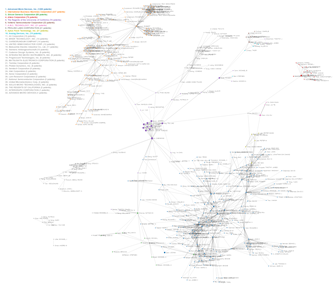Patent Co-Invention Network Tool
As part of our work understanding a particular breakthrough technology, we wanted to see the relationships of inventors working together that made it possible. Our visualization specialist, Guan-Cheng Li, created a live-rendering social network diagram (with links between inventors representing that they were both listed as inventors on the same patent in the chosen time frame) for some sample data we manually gathered.I then programmed an automated tool (using PHP/MySQL) that creates these social network diagrams for any chosen inventor(s) or technological areas, in any given time frame (since 1975, since our data begins then). It can classify inventors by their affiliations (businesses or universities they worked for), or by affiliation with “academia” or “industry” in order to explore academic invention’s evolving role in industrial science. That tool is available here:
The following sample images represent the networks surrounding a set of professors at UC Berkeley, who together invented a particularly important semiconductor technology in the late 1990s:
Inventors, co-inventors, and co-co-inventors within 1990-2001

Inventors, co-inventors, co-co-inventors, and co-co-co-inventors within 1996-2001

Code samples:
Here is the code that generates this, with login credentials to the databases removed:
https://github.com/oreagan/socialnetwork
